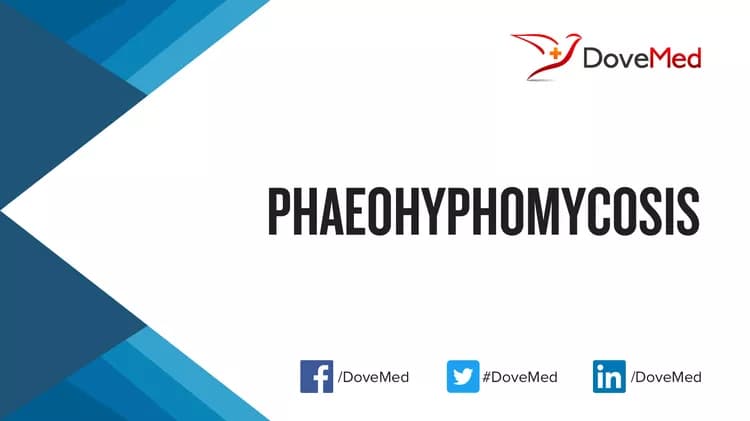What are the other Names for this Condition? (Also known as/Synonyms)
- PHM (Phaeohyphomycosis)
What is Phaeohyphomycosis? (Definition/Background Information)
- Phaeohyphomycosis (PHM) constitutes a group of fungal infections caused by dematiaceous fungi, meaning that in these infections, the skin appears darkly-pigmented due to melanin deposition into the cell walls
- Phaeohyphomycosis are severe opportunistic infections that mostly affect the immunocompromised with widespread disease. Apart from skin, the infection can involve several regions of the body, such as the bones, lungs, heart, and brain, with life-threatening complications
- The condition is difficult to treat. The treatment of Phaeohyphomycosis may involve antifungal medications, appropriate management of the symptoms and complications, including surgery, if necessary. The prognosis of the infection depends on early diagnosis and adequate treatment support, but is mostly poor
Who gets Phaeohyphomycosis? (Age and Sex Distribution)
- Phaeohyphomycosis typically affects immune-compromised adults, although individuals of all ages may contract the infection
- Both males and females may be affected
- Worldwide, individuals of all racial and ethnic groups may be affected
What are the Risk Factors for Phaeohyphomycosis? (Predisposing Factors)
The risk factors for Phaeohyphomycosis may include:
- Skin wounds
- Compromised immunity due to immunosuppressant medications, such as after organ transplantation, or disease (HIV infection/AIDS)
- Certain underlying chronic health conditions (such as diabetes and tuberculosis)
- Malignancies such as lymphoma and leukemia
- Use of topical or systemic corticosteroids
It is important to note that having a risk factor does not mean that one will get the condition. A risk factor increases one’s chances of getting a condition compared to an individual without the risk factors. Some risk factors are more important than others.
Also, not having a risk factor does not mean that an individual will not get the condition. It is always important to discuss the effect of risk factors with your healthcare provider.
What are the Causes of Phaeohyphomycosis? (Etiology)
Phaeohyphomycosis are caused by ubiquitous pigmented fungi (dematiaceous fungi) belonging to several genera, including:
- Alternaria
- Bipolaris
- Cladophialophora
- Cladosporium
- Exophiala
- Fonsecaea
- Phialophora
- Ochronosis
- Rhinocladiella
- Wangiella
Of these, the most common causative fungal species include:
- Alternaria alternatea
- Exophiala jeanselmei
- Wangiella (Exophiala) dermatitidis
A majority (over 40%) of cerebral Phaeohyphomycosis cases are caused by Cladophialophora bantiana.
- In most cases, the causative fungi are opportunistic organisms, affecting those with compromised immunity. However, on rare occasions, those who are immune-competent may be affected as well
- Individuals, who apply topical steroids or take oral corticosteroids, may be susceptible to local infections
What are the Signs and Symptoms of Phaeohyphomycosis?
The signs and symptoms of Phaeohyphomycosis may include:
- Presence of papules and plaques anywhere on the body
- Nodules or abscesses beneath the skin
- Corneal inflammation (keratitis) due to eye infection
- Invasive sinusitis which may occur with bone necrosis
- Development of lung masses
- Osteomyelitis (bone infection)
- Mycotic arthritis - when the infection affects the bone joints
- Endocarditis
- Brain abscess
Disseminated (widespread) infection is generally noted in individuals with poor immunity.
How is Phaeohyphomycosis Diagnosed?
Phaeohyphomycosis is diagnosed on the basis of the following information:
- Physical examination and a complete medical history
- Fungal culture of pus swabs
- Dermoscopy: Dermoscopy is a diagnostic tool where a dermatologist examines the skin using a special magnified lens
- Wood’s lamp examination: In this procedure, the healthcare provider examines the skin using ultraviolet light. It is performed to examine the change in skin pigmentation
- Potassium hydroxide (KOH) preparation: Microscopic observation of a sample to detect fungal structures
- Skin biopsy: A skin tissue biopsy is performed and sent to a laboratory for a pathological examination. The pathologist examines the biopsy under a microscope. After putting together clinical findings, special studies on tissues (if needed) and with microscope findings, the pathologist arrives at a definitive diagnosis
- The following may be performed on a biopsy of the affected tissue:
- Masson-Fontana staining of specimen to delineate melanin-producing fungi
- Culture of specimen to identify causative fungus and confirm Phaeohyphomycosis
Many clinical conditions may have similar signs and symptoms. Your healthcare provider may perform additional tests to rule out other clinical conditions to arrive at a definitive diagnosis.
What are the possible Complications of Phaeohyphomycosis?
The complications of Phaeohyphomycosis may include:
- Scarring due to lesions on skin
- Severe pain due to osteomyelitis or arthritis
- Severe organ involvement with organ failure
- Progression to systemic infection with severe involvement of the heart and central nervous system
Complications may occur with or without treatment, and in some cases, due to treatment also.
How is Phaeohyphomycosis Treated?
The treatment for Phaeohyphomycosis is generally challenging due to widespread disease, medications that are ineffective against some fungal species, and poor immune status of the affected individuals.
In general, the healthcare provider may consider the following treatment measures:
- Antifungal medications, which may include itraconazole, voriconazole, posaconazole, or amphotericin B, or a combination of these (particularly, if brain abscess is present)
- Symptomatic treatments
- Surgical excision of subcutaneous nodules, as needed
- Surgical resection of brain abscess, if feasible
Regular medical screening at periodic intervals with tests and physical examinations are recommended.
How can Phaeohyphomycosis be Prevented?
Phaeohyphomycosis may be prevented by considering the following measures:
- Adequately treat open wounds
- Getting treatment for any underlying medical condition(s) that may decrease immunity in the individual
- Adhering to healthcare provider’s instructions on use of topical steroids
- Seeking prompt medical attention for signs and symptoms that resemble fungal infections may help decrease the severity of infection
What is the Prognosis of Phaeohyphomycosis? (Outcomes/Resolutions)
The prognosis of Phaeohyphomycosis is dependent upon the severity of the signs and symptoms and associated complications, if any. Individuals with mild conditions have better prognosis than those with severe symptoms and complications.
- In a majority of cases, the prognosis is reportedly poor, particularly in immunocompromised individuals with systemic disease
- Also, if brain abscess or disseminated infection develops, the prognosis is known to be poor
Additional and Relevant Useful Information for Phaeohyphomycosis:
The following DoveMed website link is a useful resource for additional information:
Related Articles
Test Your Knowledge
Asked by users
Related Centers
Related Specialties
Related Physicians
Related Procedures
Related Resources
Join DoveHubs
and connect with fellow professionals



0 Comments
Please log in to post a comment.